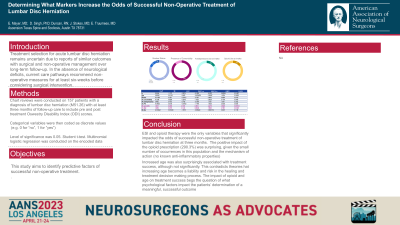Determining What Markers Increase the Odds of Successful Non-Operative Treatment of Lumbar Disc Herniation
Determining What Markers Increase the Odds of Successful Non-operative Treatment of Lumbar Disc Herniation
Friday, April 21, 2023


John Stokes, MD
Neurosurgeon
Ascension Texas Spine and Scoliosis
Austin, Texas, United States
ePoster Presenter(s)
Introduction: This study aims to identify factors predictive of successful non-operative treatment.
Methods: 157 charts of patients for lumbar disc herniation were reviewed. Demographic and clinical data were collected. Multinomial logistic regression was conducted on the encoded data.
Results: Mean age was 50.6 years. Most patients (81%) were never smokers, while 13% were former smokers and 6% were current smokers. 139 patients had the presence of a comorbidity, and 16% were being treated with antidepressants for anxiety/depression and 15% were already taking opioids at the time of the first encounter. Mean duration of symptoms was 78.3 weeks. 95% of patients received a prescription, 69% had at least one epidural injection, 50% went to physical therapy and 16% received a prescription for opioids. Only injection therapy and opioid treatment were significant predictors of treatment success with odds of 2.8 and 3.9, respectively. As expected, smoking and presence of comorbidities decreased the odds of successful non-operative treatment by 1.1% and 28.1%, respectively. Interestingly, for each unit increase in age, the odds of successful outcome increased by 2.5%.
Conclusion : Injection and opioid therapy were the only variables that significantly impacted the odds of successful non-operative treatment on lumbar disc herniation at three months. The positive impact of opioid prescription was surprising, given the small number of occurrences in this population and the mechanism of action, with no known local oranti-inflammatory properties. Increased age was also positively correlated with treatment success, although non-significantly. This contradicts the theories that increasing age becomes a liability and a risk in the healing process and treatment decision making process.
Methods: 157 charts of patients for lumbar disc herniation were reviewed. Demographic and clinical data were collected. Multinomial logistic regression was conducted on the encoded data.
Results: Mean age was 50.6 years. Most patients (81%) were never smokers, while 13% were former smokers and 6% were current smokers. 139 patients had the presence of a comorbidity, and 16% were being treated with antidepressants for anxiety/depression and 15% were already taking opioids at the time of the first encounter. Mean duration of symptoms was 78.3 weeks. 95% of patients received a prescription, 69% had at least one epidural injection, 50% went to physical therapy and 16% received a prescription for opioids. Only injection therapy and opioid treatment were significant predictors of treatment success with odds of 2.8 and 3.9, respectively. As expected, smoking and presence of comorbidities decreased the odds of successful non-operative treatment by 1.1% and 28.1%, respectively. Interestingly, for each unit increase in age, the odds of successful outcome increased by 2.5%.
Conclusion : Injection and opioid therapy were the only variables that significantly impacted the odds of successful non-operative treatment on lumbar disc herniation at three months. The positive impact of opioid prescription was surprising, given the small number of occurrences in this population and the mechanism of action, with no known local oranti-inflammatory properties. Increased age was also positively correlated with treatment success, although non-significantly. This contradicts the theories that increasing age becomes a liability and a risk in the healing process and treatment decision making process.
